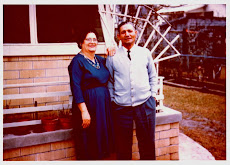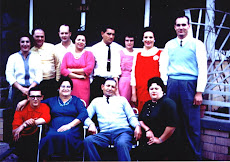
Photo: Sima Kovacevich Rosetti with her youngest son, Peter.
My great-grandmother, Sima Kovacevich Rosetti, was what is known as a formidable woman. Her opinions were widely admired and frequently aired. Her advice was coveted -- and freely dispensed. Her authority was like that of a convent's mother superior, absolute, unequivocal and rarely challenged.
Though raised in a patriarchal culture, she was said to be extraordinarily self-possessed, even as a young girl. In the Old Country, her parents were often warned that a girl so strong-willed would have a hard time finding a husband.
Few people alive today remember her, yet she was always reverentially referred to in the family as a "great lady."
In these handed-down memories, hers is a tall, looming presence, though photos reveal she actually was quite small in stature. Her posture -- head held high, shoulders squared, back ramrod straight -- gave the illusion of physical height.
Her hair, like my mother's, was jet black and pulled back from a face that -- in photos at least -- habitually wore a proud, even haughty, expression .
She wore enameled earrings fashioned like minature turbaned heads, symbolic of the Croats' victory over the invading Turks -- evidence of her ethnic pride and tenacity. Forgiving and forgetting was not part of her culture nor her individual make-up.
She was widowed right after the First World War, and left to raise five children in a country she had inhabited only a handful of years and still knew little about. Twice creditors tried to foreclose on her house on First Street, a fine Creole cottage. Yet she always managed to keep the wolves at bay.
She wore enameled earrings fashioned like minature turbaned heads, symbolic of the Croats' victory over the invading Turks -- evidence of her ethnic pride and tenacity. Forgiving and forgetting was not part of her culture nor her individual make-up.
She was widowed right after the First World War, and left to raise five children in a country she had inhabited only a handful of years and still knew little about. Twice creditors tried to foreclose on her house on First Street, a fine Creole cottage. Yet she always managed to keep the wolves at bay.
She orchestrated her children's lives well into their adulthood. Some of them lived with her several years into their marriages. My mother and most of her siblings and cousins were born in Sima's house. Her grandchildren adored and respected her.
She was a mother figure and honorary head of household to many.
Young couples sought her advice on marriage, housekeeping and making ends meet. New mothers turned to her for help with colicky babies and wayward children. Her younger sister and brother consulted her when it came time for their sons to start wearing long pants, their daughters stockings and heels.
Her kitchen was the neighborhood's cooking school. Her daughters, daughters-in-law, nieces, younger cousins, all learned the art of soup and strudel from the master.
On her sideboard she kept glass jars filled with lemon drops, cherry lozenges, peppermints and hard licorice to be dispensed as rewards and favors to the family children. At her decree, no one else was allowed to stockpile these treats. It would never have occurred to them to do otherwise.
Before the Slavonian Lodge was built, her house was a gathering place. Young girls learned how to dance on her front porch, chaperoned by Sima and partnered by her three handsome sons Vitsie, Bruno and Peter.
On her sideboard she kept glass jars filled with lemon drops, cherry lozenges, peppermints and hard licorice to be dispensed as rewards and favors to the family children. At her decree, no one else was allowed to stockpile these treats. It would never have occurred to them to do otherwise.
Before the Slavonian Lodge was built, her house was a gathering place. Young girls learned how to dance on her front porch, chaperoned by Sima and partnered by her three handsome sons Vitsie, Bruno and Peter.
Sima had a green thumb. Her flowers, some growing as tall as she, were the envy of the neighborhood. She grew them for the glory of God to grace the altar at the old St. Michael's Church. Like most Point residents, her life revolved around the Church.
Although the soil of the low-lying Mississippi Gulf Coast is vastly different from that of rocky coastal Dalmatia, she managed to maintain a small vineyard in her backyard with cuttings brought over from her homeland. My mother recalled stomping grapes as a child -- yielding just enough wine to be given out as Christmas gifts or shared on special occasions.
Sima was so well regarded that a local widower once came calling with his six sons , bearing presents, in tow and offered her pick of the litter as a son-in-law -- and threw himself into the bargain. It is a testament to Sima's diplomacy that she managed to turn down his offer (much to my grandmother's relief) while still maintaining the entire family's friendship.
The widow, herself, was much sought after, but she was done with men's follies. She had followed one across an ocean. That was enough in her book.
When the Coast Guard Station was established on Point Cadet, neighborhood goodwill was not exactly forthcoming. It was a tightly knit community that did not welcome outsiders with unknown missions and motives.
The new base's officers, knowing where the neighborhood's social power lay, came calling on Sima with polished brass and hats in hand. They admired her flowers, sipped her homemade wine and complimented her strudel. and biscutine At the end of the visit, she proclaimed them "gentlemen" and the word spread that the U.S. Coast Guard was now welcome on Point Cadet. As went Sima, so went the rest of the neighborhood
The new base's officers, knowing where the neighborhood's social power lay, came calling on Sima with polished brass and hats in hand. They admired her flowers, sipped her homemade wine and complimented her strudel. and biscutine At the end of the visit, she proclaimed them "gentlemen" and the word spread that the U.S. Coast Guard was now welcome on Point Cadet. As went Sima, so went the rest of the neighborhood
For Christmases thereafter, my mother delivered trays of pastry and bottles of wine to the station's gate on her grandmother's behalf and bore back handwritten thank-you notes from the station's front office.
Despite her strong constitution and iron will, Sima did not live to a ripe old age. Still in her 50's she succumbed after a long and terrible bout with stomach cancer. She stayed in control until the very end. She refused the hospital's food. As long as she was able to eat, her children delivered food, cooked from her own recipes in her own kitchen. After she was discharged to spend her final days at home, she insisted the young people dance on her porch and had the windows thrown open so she could hear the music.
When the end came, she called for a clean nightgown and her Mavis talcum powder. She instructed my mother to remove the Turk earrings from her ears.
And, only then, her will done, did Sima give up the ghost.
And, only then, her will done, did Sima give up the ghost.
BISCUTINE
These twice-baked hard "dunking" cookies are more popularly known today by their Italian name of "biscotti." They are usually flavored with vanilla and anise. You can use any type of nut. Pecans are traditional on the Point, but I prefer almonds. Because they keep well in cookie tins, they were often made and served to drop-in guests with a cup of coffee or hot tea or a glass of sweet homemade wine.
2 cup of chopped nuts (almonds, pecans, walnuts or pistachios)
1 tsp. vanilla
1 tsp. salt
1 1/2 sticks of butter, softened
2 tsp. essence of anise (do not use extract)
4 eggs
2 cups sugar
4 cups of all-purpose flour
2 tsp. baking powder
1 tsp. baking soda
Sift together flour, baking soda, baking powder and salt. Cream butter and sugar. Add eggs and mix well. Stir in flour mixture, vanilla, anise and nuts. Divide dough into three sections. Roll each into a log and place on a cookie sheet. Bake at 350 degrees until golden brown., about 30 minutes While still hot, slice into 1-inch thick slices. Places slices flat on a cookie sheet and bake again until hard. Cool and store in tins.


No comments:
Post a Comment